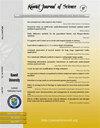Variability in rainfall and meteorological drought over the Banas River Basin under climate change scenarios
IF 1.1
4区 综合性期刊
Q3 MULTIDISCIPLINARY SCIENCES
引用次数: 0
Abstract
This study explores the historical and future variability in rainfall and meteorological drought over the semi-arid Banas River Basin in Rajasthan, India. For this, both historical (1981–2020) and projected (2021–2100) gridded rainfall data have been collected from the India Meteorological Department (IMD), Pune, and the Coordinated Regional Downscaling Experiment (CORDEX) under Representative Concentration Pathways (RCPs) 2.6, 4.5, and 8.5, respectively. The collected data have been analyzed using descriptive statistics (mean, minimum, maximum, skewness, kurtosis, coefficient of variability, and standard deviation) and trend tests (Mann-Kendall and Sen's slope). The severity of drought has been evaluated using the Standardized Precipitation Index (SPI) at multiple time spans (1-, 3-, 6-, 9-, and 12-month). The findings reveal a reduction in the quantity of annual rainfall in the near (2021–2060) and far (2061–2100) future as compared to the historical time period, particularly under RCP4.5 and RCP8.5 scenarios. In the future, the duration, severity, intensity, and frequency of drought will intensify despite the increasing (non-significant) trends in annual rainfall. The maximum frequency has been estimated for mild droughts, followed by moderate and severe droughts. The longest duration of drought (12 years) will occur at the SPI 9- and 12-month scale in the near future (RCP8.5). These findings will be valuable for researchers, water resource managers, agricultural stakeholders, and policymakers in developing effective strategies related to systematic management of water resources and drought over the Banas River Basin, India.
气候变化情景下巴纳斯河流域降雨和气象干旱的变率
本研究探讨了印度拉贾斯坦邦半干旱巴纳斯河流域降水和气象干旱的历史和未来变化。为此,分别在代表性浓度路径(rcp) 2.6、4.5和8.5下,从印度气象局(IMD)、浦那和协调区域降尺度实验(CORDEX)收集了历史(1981-2020)和预测(2021-2100)网格化降雨数据。使用描述性统计(平均值、最小值、最大值、偏度、峰度、变异系数和标准差)和趋势检验(Mann-Kendall和Sen's斜率)对收集到的数据进行分析。利用标准化降水指数(SPI)在多个时间跨度(1个月、3个月、6个月、9个月和12个月)对干旱的严重程度进行了评估。研究结果表明,与历史时期相比,近期(2021-2060)和远期(2061-2100)的年降雨量有所减少,特别是在RCP4.5和RCP8.5情景下。未来,尽管年降雨量呈增加趋势(不显著),干旱的持续时间、严重程度、强度和频率仍将加剧。据估计,轻度干旱的频率最高,其次是中度和重度干旱。近期在SPI 9个月和12个月尺度(RCP8.5)将出现最长干旱持续时间(12年)。这些发现对于研究人员、水资源管理者、农业利益相关者和决策者制定与印度巴纳斯河流域水资源和干旱系统管理相关的有效战略具有重要价值。
本文章由计算机程序翻译,如有差异,请以英文原文为准。
求助全文
约1分钟内获得全文
求助全文
来源期刊

Kuwait Journal of Science
MULTIDISCIPLINARY SCIENCES-
CiteScore
1.60
自引率
28.60%
发文量
132
期刊介绍:
Kuwait Journal of Science (KJS) is indexed and abstracted by major publishing houses such as Chemical Abstract, Science Citation Index, Current contents, Mathematics Abstract, Micribiological Abstracts etc. KJS publishes peer-review articles in various fields of Science including Mathematics, Computer Science, Physics, Statistics, Biology, Chemistry and Earth & Environmental Sciences. In addition, it also aims to bring the results of scientific research carried out under a variety of intellectual traditions and organizations to the attention of specialized scholarly readership. As such, the publisher expects the submission of original manuscripts which contain analysis and solutions about important theoretical, empirical and normative issues.
 求助内容:
求助内容: 应助结果提醒方式:
应助结果提醒方式:


